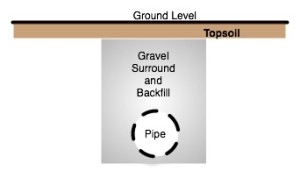Agricultural Drains
Agricultural drains (often called aggi drains) are used to:
- Drain waterlogged ground.
- Avoid soil heave by keeping your foundations dry (see this Link: Protect foundations)
- Keep the soil behind retaining walls dry. (see this link: Retaining Walls)
Existing Drains
In the old days agricultural drains used to be constructed out of short lengths of clay pipe butted together without proper joints. (If you are building on a demolition site you may still come across these pipes.)
The water seeped into the pipe through these butt joints.
Current Method
Nowadays agricultural drains come in two types:
-
- White slotted UPVC pipes with longitudinal slots which come in straight lengths (usually 6m long).
- Black corrugated UPVC pipes with lateral slots that come on coils of various lengths.
For domestic jobs the black corrugated coils are probably the easiest option.
DON’T get the pipes with a Geotextile ‘Sock’ around the Pipe (see this link: Geotextiles Around Drainage Pipes)
Laying Aggie Pipes
You don’t need to be a plumber to lay agricultural drains in your garden. Some advice for laying the pipes are:
- The pipes should be laid at a gradient of no flatter than 1 in 100 (1cm in 1m) to the point to which the flow will be directed. A gradient of 1 in 50 is better!
- When excavating a trench for agricultural drains you need to dig the trench at a width of at least twice the width of the pipe and at least 25mm deeper than the level of the pipe.
- Lay 25mm of 10mm gravel in the trench keeping it at the set gradient.
- Lay the pipe along the top of the gravel keeping it as straight as possible.
- Fill the trench with 10mm gravel to 100mm below ground level.
- Fill the last 100mm with topsoil.
- Make sure you have a silt trap before the point where you connect to the point of discharge.(see this link: Silt Trap)
